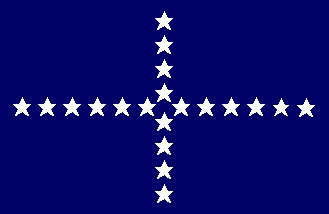 by Devereaux Cannon
by Devereaux Cannon
Last modified: 2010-02-19 by ian macdonald
Keywords: empire | navy | cruzeiro | jack | admiral | vice admiral | rear-admiral |
stars: 21 (white) | stars: 5 (white) | stars: 4 (white) | stars: 3 (white) | stars: 2 (white) |
Links: FOTW homepage |
search |
disclaimer and copyright |
write us |
mirrors
The flags below are properly dark blue. It should be pointed out that reports of dark green jacks, pennants, and
command flags in the Brazilian Navy were erroneous. The blue jack with white stars arranged in a cross
dates to 1847, and this jack as well as the blue pennant and command flags
derived from it consistently appear in official publications of major foreign
navies (French, German, UK, and US) from 1858 onward. One reference (Hounsell,
1873) appears to be the source of the erroneous green flag reports.
Joe McMillan, Ralph Kelly, 25 March 2009
From the 1882 U.S. Navy
publication, Flags of Maritime Nations.
Devereaux Cannon, 25 October 1999
Cruzeiro of 20 stars (without the central one).
Željko Heimer, 27 March 2001
Siebmacher (1876) shows the blue flag with 20 stars, horizontal 6-6,
vertical 4-4, the center being empty space for one further star. He
names it Commandoflagge, and gives proporions of 4:7.
Ralf Stelter, 23 March 2001
The 1858 Album des Pavillons by LeGras calls this the "command flag" with the notes that it is flown
by an admiral at the head of the mainmast, by a vice admiral at the foremast), and by a chef d'escadre at the mizzen. Chefe de
esquadra was the Brazilian rank title equivalent to a rear admiral throughout the imperial period (unlike the old French term chef d'escadre,
which was one step junior to a contre-amiral. LeGras also says this flag was displayed at the bow (i.e., as a jack) whenever the ensign was flown
at the stern. He also gives the proportions as 4:7. The same design appears in the 1870 edition of Flags of
Maritime Nations.
Joseph McMillan, 28 March 2001
From the 1882 U.S. Navy
publication, Flags of Maritime Nations.
Devereaux Cannon, 25 October 1999
Triangular cruzeiro pennant with 20 stars arranged so that
4 stars are "out of cruzeiro."
Željko Heimer, 27 March 2001
LeGras calls this the "triangle of command," giving proportions
2:5, and says it is flown by a chef de division, which in
Portuguese is chefe de divisão, the imperial Brazilian rank equivalent to a commodore.
Labeled "commodore's triangle" in Flags of Maritime Nations.
Joseph McMillan, 28 March 2001
From the 1882 U.S. Navy
publication, Flags of Maritime Nations.
Devereaux Cannon, 25 October 1999
Blue long
pennant with 14 stars, of which two are set "crossing" the line of stars
between the 3rd and 4th from hoist. Is there any significance to the number 14?
Željko Heimer, 27 March 2001